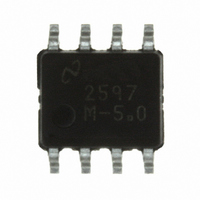LM2597M-5.0/NOPB National Semiconductor, LM2597M-5.0/NOPB Datasheet - Page 14

LM2597M-5.0/NOPB
Manufacturer Part Number
LM2597M-5.0/NOPB
Description
IC REG SIMPLE SWITCHER 8-SOIC
Manufacturer
National Semiconductor
Series
SIMPLE SWITCHER®r
Type
Step-Down (Buck)r
Datasheet
1.LM2597M-3.3NOPB.pdf
(34 pages)
Specifications of LM2597M-5.0/NOPB
Internal Switch(s)
Yes
Synchronous Rectifier
No
Number Of Outputs
1
Voltage - Output
5V
Current - Output
500mA
Frequency - Switching
150kHz
Voltage - Input
4.5 ~ 40 V
Operating Temperature
-40°C ~ 125°C
Mounting Type
Surface Mount
Package / Case
8-SOIC (3.9mm Width)
Primary Input Voltage
12V
No. Of Outputs
1
Output Voltage
5V
Output Current
500mA
No. Of Pins
8
Operating Temperature Range
-40°C To +125°C
Supply Voltage Range
4.5V To 40V
Filter Terminals
SMD
Rohs Compliant
Yes
Input Voltage Primary Max
40V
Lead Free Status / RoHS Status
Lead free / RoHS Compliant
Power - Output
-
Other names
*LM2597M-5.0
*LM2597M-5.0/NOPB
LM2597M-5.0
*LM2597M-5.0/NOPB
LM2597M-5.0
Available stocks
Company
Part Number
Manufacturer
Quantity
Price
Part Number:
LM2597M-5.0/NOPB
Manufacturer:
TI/德州仪器
Quantity:
20 000
www.national.com
5. Catch Diode Selection (D1)
A. The catch diode current rating must be at least 1.3 times
greater than the maximum load current. Also, if the power
supply design must withstand a continuous output short, the
diode should have a current rating equal to the maximum
current limit of the LM2597. The most stressful condition for
this diode is an overload or shorted output condition.
B. The reverse voltage rating of the diode should be at least
1.25 times the maximum input voltage.
C. This diode must be fast (short reverse recovery time) and
must be located close to the LM2597 using short leads and
short printed circuit traces. Because of their fast switching
speed and low forward voltage drop, Schottky diodes provide
the best performance and efficiency, and should be the first
choice, especially in low output voltage applications. Ultra-fast
recovery, or High-Efficiency rectifiers are also a good choice,
but some types with an abrupt turn-off characteristic may
cause instability or EMl problems. Ultra-fast recovery diodes
typically have reverse recovery times of 50 ns or less. Recti-
fiers such as the 1N4001 series are much too slow and should
not be used.
6. Input Capacitor (C
A low ESR aluminum or tantalum bypass capacitor is needed
between the input pin and ground to prevent large voltage
transients from appearing at the input. In addition, the RMS
current rating of the input capacitor should be selected to be
at least
data sheet must be checked to assure that this current rating
is not exceeded. The curve shown in Figure 16 shows typical
RMS current ratings for several different aluminum electrolytic
capacitor values.
This capacitor should be located close to the IC using short
leads and the voltage rating should be approximately 1.5
times the maximum input voltage.
If solid tantalum input capacitors are used, it is recomended
that they be surge current tested by the manufacturer.
Use caution when using ceramic capacitors for input bypass-
ing, because it may cause severe ringing at the V
For additional information, see section on input capacitor
in application information section.
LM2597/LM2597HV Series Buck Regulator Design Procedure (Adjustable
Output)
PROCEDURE (Adjustable Output Voltage Version)
1
⁄
2
the DC load current. The capacitor manufacturers
(Continued)
IN
)
IN
pin.
14
5. Catch Diode Selection (D1)
A. Refer to the table shown in Figure 10 . Schottky diodes
6. Input Capacitor (C
voltage rating is 50V, a 50V capacitor should be used. The
capacitor voltage rating of (1.5 x V
this example, with a 400 mA load, a capacitor with a RMS
current rating of at least 200 mA is needed.
The curves shown in Figure 16 can be used to select an
To further simplify the buck regulator design procedure, Na-
tional Semiconductor is making available computer design
software to be used with the Simple Switcher line ot switching
regulators. Switchers Made Simple (version 4.1 or later) is
available at National’s web site, www.national.com.
provide the best performance, and in this example a 1A, 40V,
1N5819 Schottky diode would be a good choice. The 1A diode
rating is more than adequate and will not be overstressed
even for a shorted output.
The important parameters for the Input capacitor are the input
voltage rating and the RMS current rating. With a nominal
input voltage of 28V, an aluminum electrolytic aluminum elec-
trolytic capacitor with a voltage rating greater than 42V (1.5 x
V
line, and can be modified somewhat if desired.
The RMS current rating requirement for the input capacitor of
a buck regulator is approximately
appropriate input capacitor. From the curves, locate the 50V
line and note which capacitor values have RMS current rat-
ings greater than 200 mA. A 47 µF/50V low ESR electrolytic
capacitor capacitor is needed.
For a through hole design, a 47 µF/50V electrolytic capacitor
(Panasonic HFQ series or Nichicon PL series or equivalent)
would be adequate. Other types or other manufacturers ca-
pacitors can be used provided the RMS ripple current ratings
are adequate.
For surface mount designs, solid tantalum capacitors are
recommended. The TPS series available from AVX, and the
593D series from Sprague are both surge current tested.
IN
) would be needed. Since the the next higher capacitor
EXAMPLE (Adjustable Output Voltage Version)
IN
)
IN
1
⁄
2
) is a conservative guide-
the DC load current. In















